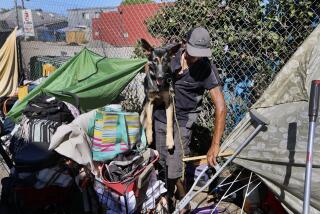Adding Luster to Youth Haven
- Share via
It began, simply enough, with a wet basketball.
At the Girls and Boys Town Emergency Shelter in Long Beach, the basketball court ended where the lawn began -- right beneath the hoop.
“A lot of times, the ball falls in the grass and it gets muddy,” said 17-year-old Emmitt, a shelter resident. When Men’s Divisions International, a volunteer community support group, heard about this, they took on the project to extend the basketball court. After visiting the two-story house, constructed in 1993, they knew they could do more. They solicited donations from supermarkets, hardware stores and nurseries for their project.
Earlier this month, 40 members spent a Saturday working with the shelter’s teenage residents painting rooms, landscaping, planting and beautifying the shelter, at Wardlow Road and Pacific Place.
Each year, more than 1,600 teenagers are referred to the organization’s two shelters -- the girls’ shelter is on West Adams Boulevard near USC. But, due to space limitations, 1,000 children are turned away every year, said spokeswoman Jeannie Whited. A third shelter will begin construction in East Rancho Dominguez, near Compton, in spring 2005.
Because there are only 16 beds, residents can stay for only 30 days. Many of the teenage boys living at the Long Beach shelter have been abused, neglected or had behavioral problems before arriving. During their stay, they work with counselors who help them develop social skills many others might find rudimentary, Whited said.
The first lesson in the shelter handbook, for example, deals with following instructions, broken into four steps: Look at the person. Say “OK.” Do what you’ve been asked right away. Check back.
“Many of them come from family situations where they didn’t acquire basic skills as youngsters,” Whited said. “These kids take the skills and generalize them when they leave.... At some point it becomes second nature.”
Applying these skills -- such as saying “It was nice to meet you” -- can earn them points toward rewards, such as sweatbands, designer sneakers and Laker caps.
“That’s all I really want,” Emmitt said, pointing to the CD player in the accomplishment case.
But it’s not just material motivation that drives the residents.
“Initially it’s about having extra privileges,” Whited said. “But then they take pride in how far they’ve come. They see how they can start to help other kids who come in the program.”
The beautification day was a prime time to exercise what they learned. They met with 40 members of Men’s Divisions International, introducing themselves and exchanging pleasantries.
They gathered in the lounge area as assignments were handed out.
“You got some muscle, we need you digging,” Men’s Division member Adam Eichhorst said to one burly kid.
The boys then huddled together, hands in the center like a football squad entering the second half.
“Are we ready to have some fun?” Eichhorst asked.
“Yeah!” the children hollered.
“Everyone, Boys Town on three. One, two, three!”
“Boys Town!” they yelled.
Eichhorst, who works on the set of the television show “JAG,” said his organization took on the project to show there are role models out there for these otherwise neglected teens.
“We want them to understand what being a man is, and that’s helping other people, working hard and showing them the value of what you can accomplish,” said the 33-year-old Eichhorst. “Hopefully they’ll be overwhelmed by the people there to support them.”
Men’s Divisions International has branches across North America, and its members come from all career backgrounds, ethnicities, religions and affiliations.
Dan Schwab, a construction worker and father of two, used a jackhammer to chip away the concrete around the basketball pole.
“These kids need a break,” said the 36-year-old Men’s Divisions member. “There are people out there that care about them who don’t want a thing in return.”
A few yards away, Robert, a 16-year-old who made money doing yard work for his uncle, volunteered for landscaping duty. He planted his shovel in the dirt with both hands, his forehead already glistening in the morning sun.
“I like it here, better than other places I was at,” said Robert, on his fourth day at the shelter. “We have more fun here.”
Behind the building, volunteers installed a shade over the wooden frame of a pergola. Another group was busy working inside, repainting the bedroom walls.
Inside Emmitt’s room, there’s not much decor, except for a collage of his sporting heroes hanging on one wall. The collage, made from newspaper and magazine clippings, is entitled “The Best.” There’s Muhammad Ali with his arms pumped standing over Sonny Liston, and Michael Jordan hitting the game-winning jumper with 6.6 seconds left on the clock.
Next to the collage, a framed quotation by William Faulkner reads: “The man who removes a mountain begins by carrying away small stones.”
By 3:30 p.m., the volunteers have laid in the 96-square-foot extension to the basketball court.
As the surface is smoothed out, several of the boys draw their names with their fingers in the wet cement.
“It feels pretty nice,” Emmitt said of the community support. “It makes us feel important, like a real man.”
More to Read
Sign up for Essential California
The most important California stories and recommendations in your inbox every morning.
You may occasionally receive promotional content from the Los Angeles Times.













